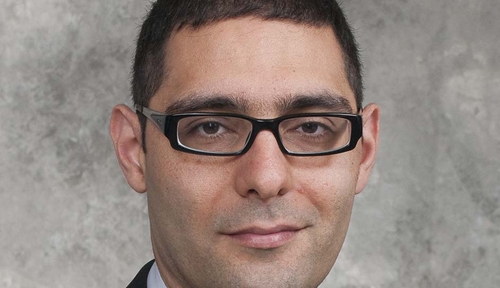Ramin Farzaneh-Far, M.D., an expert in an emerging field of study in aging, will be the guest speaker for the University of Nebraska Medical Center’s Denham Harman, M.D., Ph.D., Lectureship in Biomedical Gerontology on Friday, April 20, at noon.
Dr. Farzaneh-Far, a cardiologist and assistant professor in the Division of Cardiology at the University of Texas Southwestern Medical Center in Dallas, studies new ways of measuring heart disease risk.
The lecture, sponsored by the UNMC Department of Internal Medicine’s Division of Cardiology, will be held in the Durham Research Center Auditorium and is open to the public. Lunch will be provided for the first 250 attendees.
His talk, titled, "Loose ends: telomeric aging in cardiovascular disease," will shed light on telomeres — the pieces of DNA on the end of chromosomes — and their relationship to aging and disease. Dr. Farzaneh-Far compares the function of a telomere to the plastic end of the shoelace in that it protects the main part of DNA. Each individual’s telomeres differ in length.
Dr. Farzaneh-Far said the theory that telomeres play a role in aging surfaced in the 1980s. In 2009, the Nobel Prize was awarded for the discovery of how chromosomes are protected by telomeres and the enzyme telomerase. Over the last five years, there has been a flurry of research on telomeres.
He said knowing telomere length in patients may help to predict heart disease and heart failure more accurately than is currently possible.
“The link between telomeres and aging is well established,” he said. “Each time cells divide they get shorter. Telomeres can’t copy the whole length of the DNA, so a little piece falls off each time. When the telomere gets too short, the cell stops dividing and functioning.
“Telomere length is related to cellular aging. In the lab, scientists have been able to add telomeres back on to DNA to keep the cell alive. Now we need to determine if the process relates to diseases.”
Dr. Farzaneh-Far said knowing telomere length adds to the body of knowledge about age-related disease. “Short telomeres are associated with cancer and heart disease but we aren’t sure if they’re involved in actually causing these diseases or if they are just markers of the disease,” he said. “What is certain is that short telomeres cause aging in cells.”
Telomere length may be a way of measuring biological age, he said. If biological age could be measured, it may be a better way to predict disease risk, which could motivate patients to change their behaviors, he added.
“One of the problems is people don’t take long-term risk for disease seriously. If telomere length could be changed, therapies might be developed to target the aging process in the heart and arteries.”
The Harman Lectureship was established in 2002 by the University of Nebraska Foundation in honor of Dr. Harman, Emeritus Millard Professor of Medicine at UNMC, who is known internationally as the father of the Free Radical Theory of Aging. He proposed the theory in 1954 and discovered the role of antioxidants (vitamins C, E and beta-carotene, in fighting heart disease, cancer, Alzheimer’s and Parkinson’s disease.
Through world-class research and patient care, UNMC generates breakthroughs that make life better for people throughout Nebraska and beyond. Its education programs train more health professionals than any other institution in the state. Learn more at unmc.edu.
-30-
